|
May 1955 Popular Electronics
 Table of Contents Table of Contents
Wax nostalgic about and learn from the history of early electronics. See articles
from
Popular Electronics,
published October 1954 - April 1985. All copyrights are hereby acknowledged.
|
Before the advent of electrical
distribution systems and electronics, the hazard of lightning was primarily from
fire ignition and, to a lesser extent, bodily injury (to humans and animals). In
fact, it was Benjamin Franklin's discovery that lightning was a form of electricity
that led to his subsequent invention of the lightning rod system that, after being
installed on Philadelphia's tallest wooden structures, significantly reduced the
incident of lightning-related devastating fires which had been ravaging the city
for years. Once cities began installing electric power lines, they were to lightning
what trailer homes* are to tornadoes - strong attractors. Line protection systems
were soon developed to help stop strikes which sometimes caused electrocution to
people inside homes who happened to be touching a light switch or plumbing fixture
(back when metal pipes were used everywhere). Then came electronics and electrical
appliances which could not withstand a high voltage surge and burned out as the
result of a lightning strike. Ungrounded television antennas were notorious for
attracting bolts of lightning and frying the innards. The TV antenna on my
parents' house never had a grounding wire so we must have lucked out since the
Annapolis, Maryland area experienced a lot of lightning storms in the summer.
* I have owned and lived in trailers twice in the last four decades, once in
Vermont when attending UVM, and again in south central Minnesota, a major tornado
region.
How to "Arrest" Lightning
By Elbert Robberson
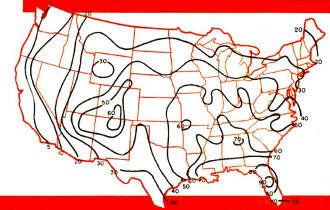
This map will give the reader an approximate idea of how many
days each year severe thunderstorms and lightning may be expected. San Francisco
readers generally have only 4 or 5 severe storms each year, but readers in New Orleans
will experience 70 or more lightning storms.
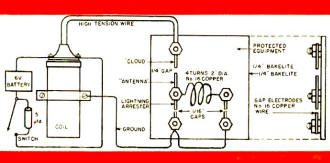
Experimental layout for demonstrating the safety factor of lightning
arresters.
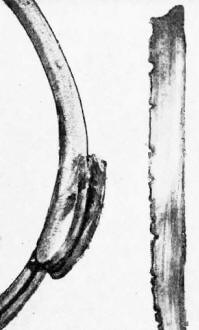
Examples of TV lead-in wires shown above have been attached to
antennas struck by lightning. On the left is a short piece of tubular TV lead-in.
All that is left is the tube since the copper wire has vaporized. On the right a
flat-type TV lead has suffered the same fate, although the copper vapor punctured
the wall.

Construction of a typical TV lightning arrester. The metal strap
connects to a ground pipe or rod. On top of the strap is a piece of insulation.
The TV lead wires are speared by the points of the gap electrodes.
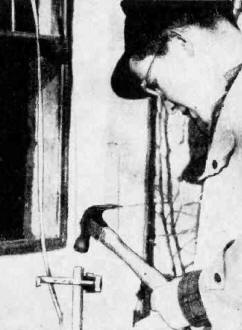
These are the steps required for safe installation of a lightning
arrester. In this photo a pipe is being driven into the ground close to the building
where the lead-in will enter the window frame. The photo is for demonstration purposes
only, as obviously it is safer to do the hammering before clamping on the arrester.
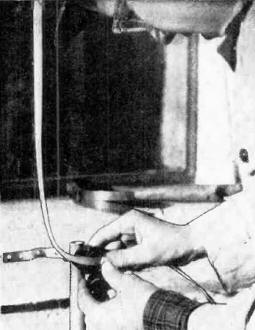
The TV lead-in at the right is placed in the arrester so that
the electrode points pierce the strands of wire. Secure the lead-in with the cap
of the arrester.

A lightning choke, which adds to the safety of the installation,
is easy to make. Loop the lead-in twice on the "protected" side of the arrester
and secure with cellophane "Scotch" tape. The lead-in should now enter the building,
preferably at a right angle.
Ninety times a year, lightning hits somewhere around Tampa, Florida. But wherever
a person lives, he begins to wonder about his antenna when one of those storm clouds
begin spit fire.
I have watched my own antenna during a lot of thunderstorms and it looks like
it keeps getting higher and higher, the closer the thunder rolls. When the bolts
start hitting close, the antenna looks as if it's the highest place around for miles,
and it seems to be begging for an electronic visitor.
"Look, now," I tell myself, "with a lightning arrester or a grounding switch,
an antenna is perfectly safe during a thunderstorm. Stop worrying!"
Then I answer myself right back. "That may be true," I say, "but does the lightning
know it?"
Lightning does know about lightning arresters. If one is installed properly,
the bolts from the blue will obey the natural law and high-tail it to ground without
touching the equipment. But if there has been a slip-up somewhere, a whole basket
full of arresters is not going to provide protection.
First, let's prove that lightning is educated to know how it should act around
an arrester. A simple experiment which can be hooked up on a workbench will show
the principles involved. If it is tried before the installation of any lightning
arresters, the constructor will be more likely to do the job right because he will
know the principles as well as the lightning does.
A miniature lightning bolt could be made with the ignition coil from a car. It
bangs out a shot of high voltage that will leap almost a half inch through the air.
To do this, use the hookup shown in the diagram.
The electrode connected to the high-tension coil terminal takes the place of
the charged cloud in a thunderstorm. The terminal directly beneath stands for the
antenna. The additional gap directly underneath goes to ground, and is the lightning
arrester. The coil off to the side represents the lead-in wire going inside the
house to the equipment, while the extra spark gap with the close spacing is what
I would call an "air-gap voltmeter" because high voltage at this point will cause
a spark to appear.
Press the key, then release it quickly. On the release, a spark should jump from
the "cloud" to the "antenna" then across the "lightning-arrester" spark gap to ground.
No spark will show at the "air-gap voltmeter," even if this gap is somewhat shorter
than the one in the "lightning arrester." Something has made shorter this gap, which
would be thought to be the "path of least resistance ", actually a path of highest
resistance. So the bolt is discharged across the lightning-arrester gap to ground,
without ever getting inside the house.
The "something" which has made the path inside the house a high-resistance route
is the inductance of the wiring and the equipment. Inductance has the electrical
property of reactance and this looks just like an "open circuit" to the fast-travelling
front of the lightning bolt. The more curly and roundabout the wiring is, the greater
the reactance.
Likewise, something has made the path through the lightning arrester to ground,
even across a longer gap, look like the path of least resistance to the lightning.
This "something" is the lack of inductance. The straighter and more direct this
path to ground can be made the easier it will be for lightning to get through.
There are over twenty different lightning arresters on the market, but all of
them depend on these principles for operation. Most arresters are simply a spark
gap in a convenient package, although there have been models that use a neon tube
which "fires" at about eighty volts, instead of an air gap. The idea behind this
is that the arrester path to ground will break down at a lower voltage than an air
gap, and so will have still less resistance to the lightning bolts.
One arrester should work as well as another if it is installed right. Suppose
we want to protect a TV antenna. First of all, the pipe supporting the antenna elements
should be grounded with a wire of 10-gauge or heavier. And no matter how many protective
devices there are down below, do not omit this heavy ground wire. If a lightning
bolt should decide to come down the antenna, and its only path is a comparatively
flimsy "twinlead," the bolt might very easily melt the small wire, then jump to
the nearest other object around. In this process, it could blow a hole in the house.
Be safe: put a heavy ground on the support. Aluminum, copper, or copper-clad steel
wire can be used.
Make the ground "run" straight and direct, with no sharp turns or bends. At the
bottom, the wire should connect to a water pipe if one is handy-but if the nearest
one is around the corner somewhere, forget it.
In this case, make a "ground" by driving a pipe or ground rod four or five feet
into the earth. Connect the ground wire to the pipe with a clamp. If a water pipe
is used make sure it goes into the ground right now and does not wander around the
cellar before connecting up with mother earth. A pipe that goes through the house
before reaching ground can induce voltages in the thousands in any nearby metal
- very undesirable in the coal bin! This is not impossible - remember how the transformer
works; a current in one wire induces a current in another one alongside. Well, this
principle works quite well outside transformers, too. A high current in the ground
conductor can induce voltages in other nearby pipes or wires. Very messy! For the
same reason, keep any other wires at some distance (and this means feet) from the
ground wire down the side of the building.
Many TV antennas have the center of the dipole connected to the support pipe.
This automatically protects the antenna cable at this point. If the antenna is not
grounded to its support, the transmission line will last longer if an outdoor type
of arrester is installed at the very top of the line, grounding it to the support
pipe. This will help keep heavy current in its place - the ground lead.
Whether or not an arrester is put at the top of the line, an arrester must be
installed at the very bottom, where the lead enters the house. Just be sure that
the connection to ground is direct and solid. Most arresters are made with terminal
teeth that automatically make the proper transmission-line connection when the wire
ribbon is clamped in place. It is not necessary to skin off the insulation.
The protection can be made even more certain by winding about a foot of the lead-in
wire on the equipment side of the arrester into a 2- or 3 -turn "lightning choke."
This coil will greatly increase the reactance of the lead-in to lightning strokes;
the signal will not be affected except on the higher-frequency channels. Many commercial
and military stations use lightning chokes in their lead-ins.
Some arresters are advertised as having a "static" drain. All this amounts to
is a high-resistance ground which is permanently connected to the antenna circuit.
The idea is that any build-up of electrons from wind friction or induction will
leak off instead of growing to the danger point.
Now, what happens when lightning strikes the arrester? It is certain that the
sparking electrodes will melt. If there is insulation in the gap, this material
will char or vaporize. Any moisture inside will turn to steam. This will happen
fast.
So if the arrester is a type which is sealed, without large exit holes for the
large cloud of gas that is going to be generated in a hurry, it is quite likely
to blow up. Install such arresters so flying parts won't damage anything nearby.
With practically any kind a new arrester will be needed if lightning strikes.
Be thankful that this one was put in right, and shell out for a new one right away,
because lightning can strike twice in the same place.
A person can keep it from raining by wearing a raincoat - maybe installing an
arrester will do the same for lightning.
Further information on lightning and lightning arresters may be obtained from
the U. S. Department of Commerce Handbook 46, Code for Protection Against Lightning
obtainable from the Superintendent of Documents, Washington 25, D. C. The latest
price is listed at 40 cents. Somewhat similar booklets are also available from various
safety agencies and insurance companies.
Editor's Note: The following concerns manufactured lightning arresters. Our readers
are referred to their nearest TV serviceman or radio parts jobber and distributor
for information on prices, installation, etc.
Amphenol, Birnbach, ICA, JFD, Radelco, RCA, RMS, Radion, Telco and Ward.
Posted August 14, 2019
|



































